The Point of the Needle:
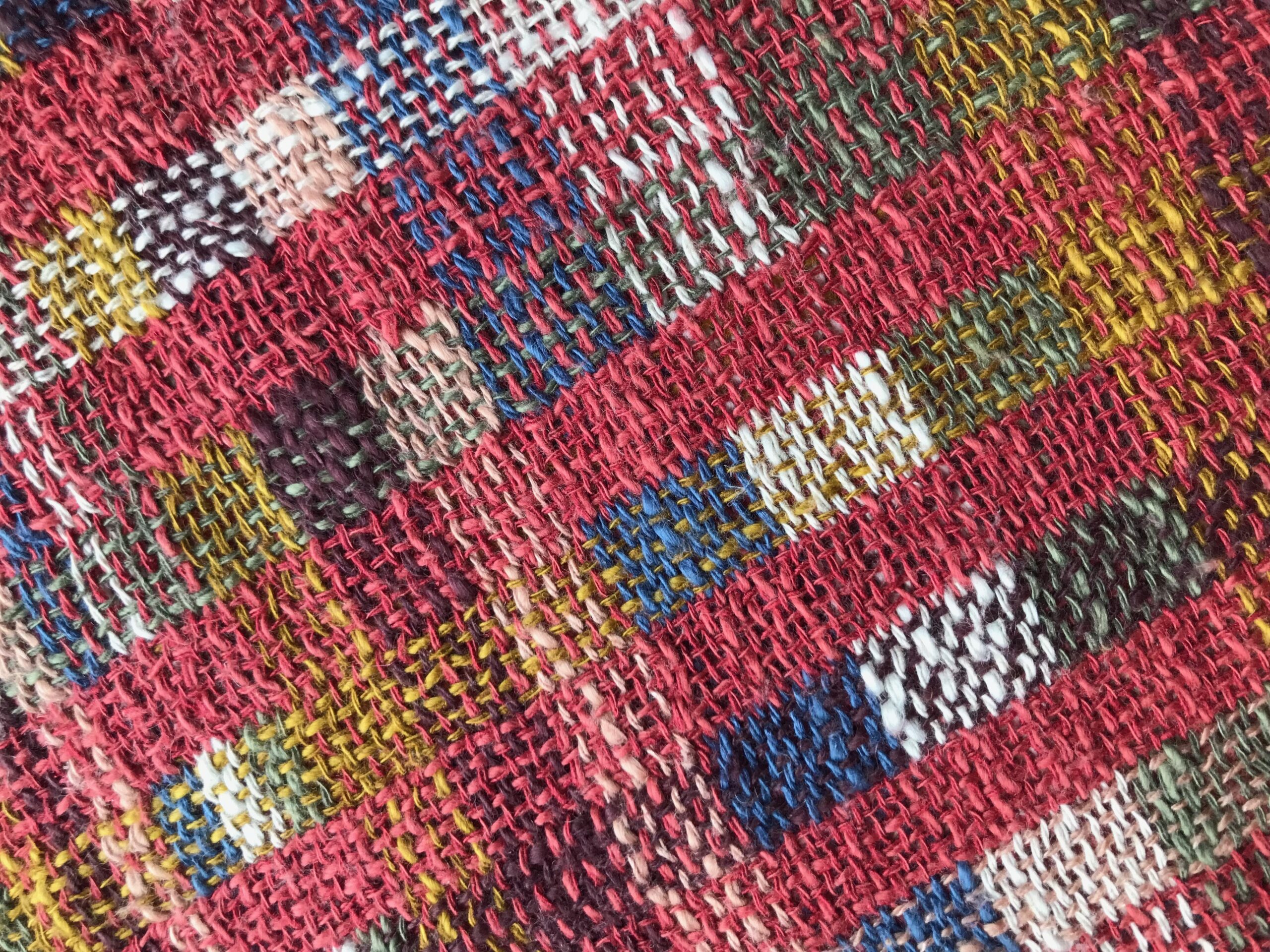
Haptic & Hue’s Book of the Year for 2023 is Barbara Burman’s The Point of The Needle. In it Barbara says ‘stitching and stitches are valued precisely because they embody human life and invention, and cloth itself is inseparable from them’. Barbara was the co-author of the well-received book called ‘The Pocket – A Secret History of Women’s Lives’, but in this new book, Barbara has a much bigger canvas: to rescue sewing from the twilight and to celebrate it as a fundamental human activity.
Barbara Burman is a writer about material culture and a former academic at the University of Southampton and the University of the Arts in the UK.
Her previous books are:
The Pocket: A Hidden History of Women’s Lives 1660-1900, written with Ariane Fennetaux, which you can find in the Haptic & Hue UK Bookshop and the US Bookshop.
Material Strategies: Dress and Gender in Historical Perspective, edited by Barbara with Carole Turbin. This is in the UK Bookshop.
The Point of The Needle is about to be published in the US (December 15th 2023). It is also in the US bookshop and the UK bookshop.
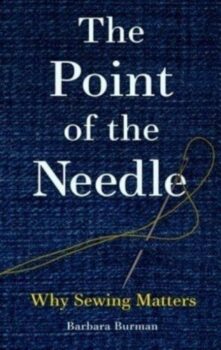
Barbara Burman’s “The Point of The Needle”
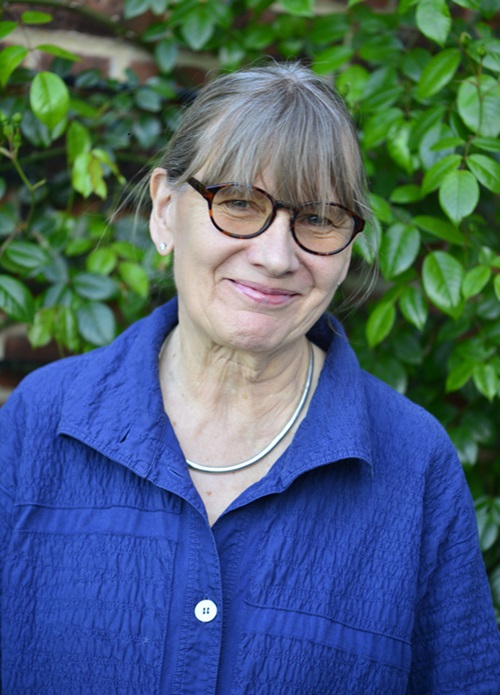
Barbara Burman
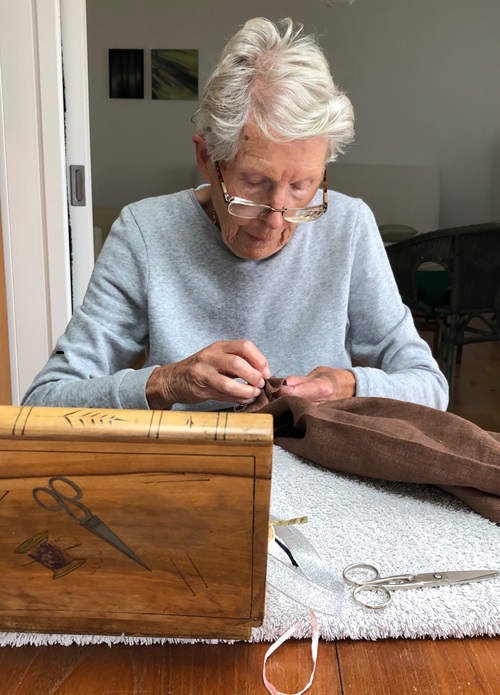
Anne Marie Rideal still sewing at 99 years old
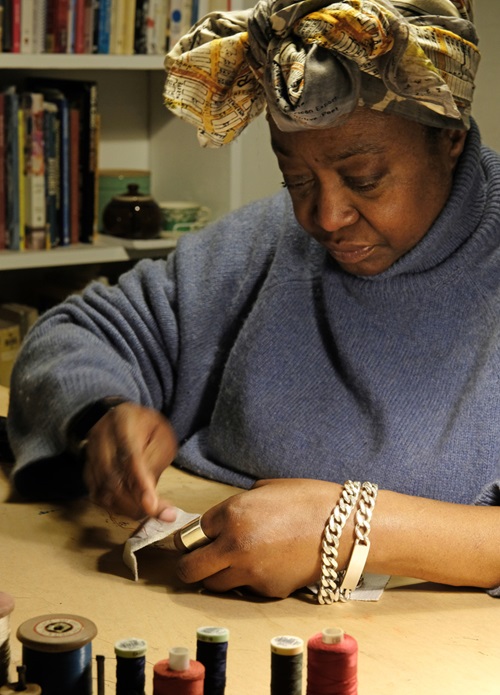
Professor Carol Tulloch sewing
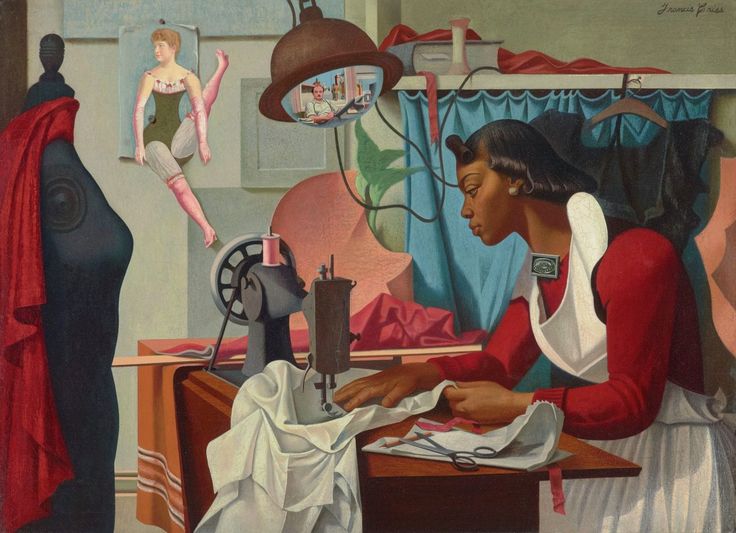
“Alma sewing” by Francis Criss, 1935
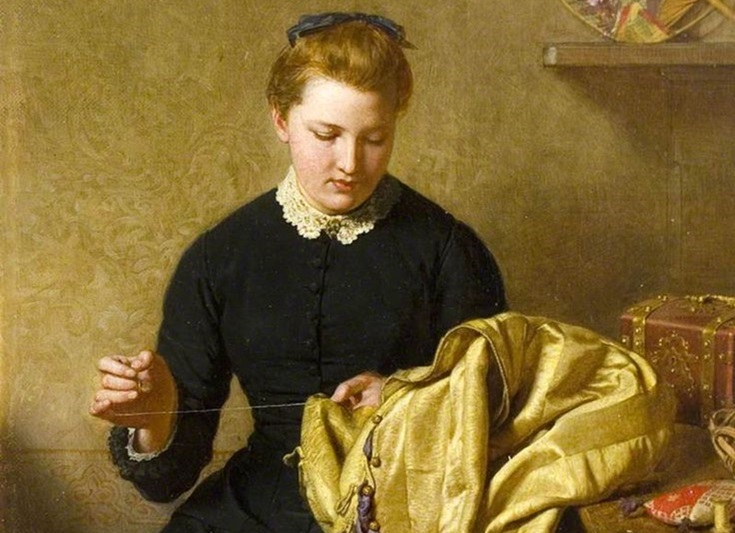
“The Little Seamstress” by John Faed

“The Seamstress” by Henry Vitofsky, Courtesy of Manchester City Art Gallery
Script
The Point of the Needle: How the Ancient Craft of Stitching Shapes Us
JA: Welcome to Haptic & Hue’s Tales of Textiles, my name is Jo Andrews and I’m a handweaver, interested in what cloth tells us about ourselves and our societies. Often the stories and information that textiles give us are ignored and we lose a whole dimension of human experience.
That is certainly true in this episode, which is a little different from the others. It’s a way of saying goodbye to 2023, and to this series of Tales of Textiles. This is the last episode of Series 5, which has seen us travel both in time and place. I wanted to end it with news of Haptic & Hue’s pick for our Book of the Year for 2023, which this time is Barbara Burman’s new book, just out, called The Point of The Needle. Barbara is a historian and she has written about textiles in the past and the role they have played in women’s lives in the book she co-authored called The Pocket – A Hidden History of Women’s Lives. But this book is a much broader one that seeks to shine a light on the extraordinary human endeavour of stitching:
Barbara: Thank you for inviting me to talk about it. I suppose in a nutshell, I wrote the book because I wanted to celebrate this ancient craft because I think, well, it’s obvious, isn’t it? Stitches are central to the way we live. I’m just looking at my jeans and my shoes and so on, even car seats and dog beds and all kinds of things. We’re dependent on the stitch. There are plenty of how to books, I mean, this is not one of them. The Point of the Needle is really about thinking about sewing, and I think that that’s how you celebrate something is to think as deeply as you can about it. And so I wanted to insert it really into serious conversations about making and about the importance of that to human flourishing. I mean, that’s where it, it belongs in a public conversation, I feel. The significance of making we are in danger of overlooking. So much comes with making, the development of problem solving, and it’s very good for mental wellbeing and so on and so on the list, as long as your arm on the benefits of doing it. And I’m, I’m afraid that we’re kind of, we may be losing this respect for making. And I actually open the book with a quote from Glen Adamson. He says, I totally agree with him. I’m just going to read it. “By better understanding the tangible things in our lives, we better understand our fellow humans”. So, this book is about people. It is about stitching, but it’s about people, and I also wanted to have a chance to just spend time listening to people who sew now, what they think, what they feel, and try to develop a picture of sewing in, in greater depth, to try to increase our awareness of, of the agency that sewing and making and craft generally brings us, and why that is vital for our flourishing, and also more and more vital, given the circumstances in which we, we find ourselves these days.
JA: Barbara spoke to a huge number of people for the book – people who sew in different circumstances, places and times, and she says that she discovered that many of them had what she called ‘sewing in the blood’.
Barbara: This was one of the things that came out in the stories, time and time again, that people were talking to me about sewing, and it’s as almost as if there is somehow sort of sewing in the blood in some families, right back to, to the 19th century when seamstresses were in the family, including my own, and learning from mothers and aunts and grannies and great grannies and, and so on. So, I, I was raised in the country, a vicarage, where there was very little money. There’s lots to do and lots to learn, and a very enriching environment. But, but there wasn’t a lot of money. And so, making was the thing. You know, we had chickens and a pig, and you grow our own vegetables. And my mother made all the textile things, including my clothes and her clothes. And so, I saw it happening all the time. I saw what value was placed on it, her, her determination to sit exams in dressmaking and, and soft tailoring. And there it was all the time. I do say in the book that she, she’s like a seam really, that runs through the book, an invisible seam, really. But I, never reached the levels of skill that she did. And I, don’t want anybody to think that I’m talking about only skilled things mattering. I think botched making is <laugh>, you know, just as valuable and often as satisfying, having a go at something.
JA: At the heart of Barbara’s book are two set of interviews carried out with stitchers 25 years apart. In the 1990s, she set up a project to record the sewing memories of several women from all walks of life. At the time it didn’t meet with great approval from her academic colleagues or her interviewees:
Barbara: The colleague, male colleagues, often, not all of them, but a lot, clearly regarded it as, you know, just a bit a bit below par, really. However, my boss did give me the time. He gave me a sabbatical. And I just, I suppose, jumped in, I just found as many elderly women. I wanted the older woman, and I mean old, you know one was just shy of her hundredth birthday. And so, they were in their seventies, eighties, nineties, and so on. And they, like my male colleagues, thought this was a bit silly. You know, so what, who’s interested in that? But when I told them it was going to go into an archive, a sound archive, one of them said, oh, that’s like having my voice in a museum, which I thought was a wonderful take on it. And once, you know, sat down with a cup of tea and, and, and they started to talk, they couldn’t be stopped, there was so much to say. And they had tremendous recall of, oh, this is the dress that my sister made me. And these buttons were self-covered with kind of heather colour. And then it had sort of blue, the sleeves were wonderful. So, you get this marvellous and, rather intriguing to me, strength of recall about what they made or what was made for them. And, they seemed to naturally tell their stories, their autobiographies, really in chapters, you know, what home they were raised in, what sort of sewing their mother did, what they were taught at school, when they got their first job, what it was like in the Second World War. And so, they were in the end, in a way, natural storytellers and said, oh, when it’s on tape, can I, can I send a copy to my family? So, they moved from, it can’t be interesting because it’s women’s work. It’s just mine, you know, who, who knows? It’s not interesting. That kind of attitude to, to this realization that there was a lot to say, and it had a long trajectory in their lives.
JA: Twenty-five years later, during COVID, Barbara repeated the exercise. She sought out as many stitchers as she could, and, this time, because she couldn’t go to them she asked them to write their sewing stories.
Barbara: Overall one’s conclusion has to be that with, with sewing, there are many, many, many continuities over generations, actually. But there are also these changes, and, I found this second tranche, if you like, very interesting. There were more ingenious ways of describing their gender. There was a much greater emphasis on sustainability and environmental issues. I mean, that was not in the conversation at all 25 years ago. The language was a bit different. Mental health was a term that cropped up again and again recently, never used by my earlier group. They did talk about liking to be creative, enjoyment, they talked about the satisfaction. So, it was slightly different vocabulary, but I think they’re probably getting at the same thing. Using different words for these, this kind of inner sense of the value to them of sewing.
JA: That was a similarity, but the two groups gave different reasons for why they chose to sew, with the second group showing, unsurprisingly, a much greater awareness of the social injustices that can lie behind commercial textile production.
Barbara: And they’re much more aware of that as an effect of fast fashion, super-fast fashion. And so, they’re positioning themselves probably true to say, they’re positioning themselves towards the outer world, perhaps more than my earlier group were doing. I think the earlier group were, were very conscious of saving money, very conscious of wanting to look fashionable and being in a situation where it was a fashion for that year or that couple of years and they wanted to fit into that, and they wanted to make things that work. So, I mean, the New Look is classic case, longing for Dior’s New Look of 47, and wanting to, to have big, lovely spread out skirts and all this kind of thing. Then that meant you had to have sort of spread out coat, and you had to think about those other things. And so, they were busy with their sewing machines to, to enjoy fashion and if they didn’t have a regular sized body, of course that meant they had to improvise a bit more.
JA: The modern stitchers are also using sewing in a much more political way, to make clothes that express their identity – rather than helping them fit in and be fashionable as the older sewers had done.
Barbara: if you feel that you are excluded from the fashion, the language and the look of fashion because you’re not in the right shape, or you are, you’re too curvy, or you’re not, you’re not, you’re not in a traditional gender slot, you want to create a new kind of visual look. You want, you, you want to create a kind of public space for yourself. You may want to be more androgynous, or you may want, you know, the complexities of gender now are, are really on the move, aren’t they? And so, you can sew your way into a, a, a place that’s yours. It expresses you and not what the big brands want you to be. And I think that’s a kind of political stitch. You think of the AIDS Memorial Quilt in, in America, if that’s not political, I don’t know what is, and more than 50 tons of it now, <laugh>, it represents so many lives that otherwise would not be in the picture. So, sewing at home has far more dimensions to it, I think, than just to say leisure. I think that in a way, some of this is quite radical. It’s not just suffragettes sewing their banners in the past. It’s quite radical. And, it’s also bringing people together. I’m thinking of organizations like the Curvy Sewing Collective in America. Thousands of people feel supported by it, because it’s, it’s allowing them to express themselves and be what they want to do, and to create clothing, and particularly clothing, but also home furnishings, that they’re not given, you know, it’s a matter of people being able to take a bit more control over what they have, what they look like, how they feel.
JA: It’s also not just women who now home sewing:
Barbara: it’s clear from other sources as well, that more men are taking it up, and I think retailers will tell you that more men are taking it up. And of course, thankfully the Americans have coined a word for it: Sew Bros. And, there are now significant number of websites that encourage men, and men talking to men about making things and how they have to, in a way, break through some kind of gender barrier and to sort of shift this within a sense of certain kinds of masculinities, and put sewing in there as an okay thing to do. I did talk to a retailer in London. She said, oh yes, they’ve been increasing numbers for some years, but they all want to make a shirt, and I’ve never made anything before. I’d like to make a shirt. And, and you explained to them, well, that is probably the most complicated thing you could start with. Oh, it can’t be that difficult, they say, and they buy a pattern and the material and off they go.
JA: How men many survive the intricate and difficult process of making a shirt – we can only guess! But in the past the emphasis of domestic sewing was on saving money, and thriftiness, being able to have fashions that you couldn’t otherwise afford. But Barbara is highlighting an important change: buying fast fashion is now cheaper than making your own, so people have found new purposes in making for themselves, their friends and families, outside that. Barbara also believes that stitching changes our relationship to consumerism and we develop a greater respect for the 70 million workers, mainly women, who sew for a living.
Barbara: I think the connection is just look at your jeans, you know, who made them? What did you pay for them? If you, if you spend 20 pounds on a T-shirt, how much of that 20 pounds is the maker getting? Usually disturbingly little. And so, I think that the making of things at home can bring with it and often does, according to the women I I talk to, a greater awareness of clothing trades, the textile trades, the social justice side of clothing. There’s one photograph in the book. It’s two hands and a button, trying to sew a button on <laugh>. We know from a recent survey that not many people know how to sew a button on. I think a photograph is for me, quite symbolic of, a major problem, it’s a symbol of our relationship to consumerism generally.
JA: Which brings us squarely to one of the great difficulties in thinking about stitching. For one set of people it brings joy, at its best, a way to express our identity, to create something that brings us pleasure, to enjoy the skills and the process of making something, and then for others employed in the textile industry it can bring misery, long hours, appalling, unsafe conditions, low pay, modern slavery and even death.
Barbara: So, we buy all this stuff. We wear our new garments, I think seven or eight times before they’re discarded. They’re discarded for numerous reasons. Buttons come off is one reason, oh, can’t wear it. Or people have changed shape, or fashions have changed, or it’s just got kind of forgotten about. And the, and the joy of shopping has taken over again. And off, off we go. So, what I find interesting is this renaissance, undoubted renaissance in sewing for yourself, whatever gender you are. And then this undoubted rise in the consumption of fast fashion. Sewing isn’t stopping. It’s growing. It grew in Covid and in Covid it was often a a way of people feeling useful because they were making protective items for health workers. And we need to remember too, that some people really like working in factories. It brings companionship and brings wages. We mustn’t be totally negative about factories, but my goodness, in the clothing trade, clothing industry, it’s it’s largely not like that. Some of the big, most familiar labels are paying below the national wage. It happens with big names who are employing people in Eastern Europe, for example. And it happens here in the UK, Leicester’s the case in point. So, we mustn’t think that it’s kind of, those problems have been sort of exported to the Far East from us. They, they are here and, and have, getting a grip on that and becoming a thoughtful consumer, I think is one of the things that sewing yourself can, can help with.
JA: So how does Barbara act as a thoughtful consumer herself?
Barbara: I like buying clothes. <Laugh>, my family will tell you, because I’ve bought what some people would call investment pieces, I am wearing things that I’ve bought 25 years ago. I don’t wear them every year, but I wear them. And I also now dig down, yes, it’s okay, you put on your website that you’ve got an anti-slavery policy or something. What does that actually mean? What are you actually doing? And where are you getting your materials from? How much do you know about your supply chain? Usually very little. Are you A B Corp? You know, that’s a good thing. I do ask myself those kinds of questions. And I was looking the other day at a, well-known High Street brand that was advertising some warm underwear as cotton. And I thought, oh, yeah, let’s have a look at the label. 52% cotton. The rest is acrylic and elastin. So, you have to teach yourself really, although there are some websites very, very helpful on all of this. And the idea that acrylic may take 200 years to degrade, it seems to me enormously shocking some of this.
Jo: So, Barbara’s rules are buy investment pieces. Look at the label. So, so what would your top three or four rules be?
Barbara: Don’t buy <laugh> immediately. Don’t rush at it. Think and go back another day and you’ll find that that amazing thing you really thought you couldn’t live without actually sort of faded slightly into the end. And this is not what I’m good at, but it’s what I know I should be good at: it’s to get all my clothes out, a great big, huge mountain of them, and give away those that maybe don’t fit me anymore or I don’t like anymore. And have a sort, have a sort. But when you love textiles, in the way I do. I, I just think, you know, that its hard <laugh. So, I think another top rule would be, apart from thinking twice before you buy, is to think, well, the next thing I’d buy, is it going to work with something I’ve already got? what am I, what am I aiming for here? And I’m, I’m trying to discipline myself so that, I mean, in theory, if you looked at my wardrobe, you think she doesn’t need any more clothes the rest of her life. <Laugh>.
JA: In her book Barbara says “I want to celebrate those who sew and to re-instate their largely untold narrative into what we choose to remember of today and the recent past”. It is a ‘phenomenon with its own history and cultural memory“. But, she adds that however we stitch it is work that is “undervalued or unseen”.
Barbara: I suppose it’s partly, it’s a bit like the air we breathe. We’re not going to talk about that all the time. And we are sitting here in clothes with these stitches. Let’s get on with life you know, that sort of absence in our minds. I suppose it’s glued to the idea that it’s women’s work. And women’s work, as we know, is overlooked, marginalized, misunderstood, devalued, underpaid, and so on and so forth. Things have changed a bit, but by and large, it’s easy to ignore and to label as women’s work. So, it’s marginal. And, that seems to be underpinned in a rather probably quite dangerous way, really, that children are coming out of school, leaving school, without much practical confidence, without much practical skill. And I think that is dangerous. it’s depriving people of one important element of being human which is to make, you know, we’ve got an opposable thumb, two opposable thumbs, most cases, let’s get on with it and use it and, and celebrate it. I think this, this, not looking at it is also part of an educational problem is part of a wider problem where we regularly divide brain work from hand work, head work from manual. If you do head work, you’re likely to earn more. If you do what’s thought of as manual work, you are likely to earn less. I mean, it’s, it’s a deep division. It’s a social division, it’s an economic division. And we, we are in that sense also overlooking the way that human <laugh> humankind isn’t made like that. Your hands are a kind of brain and children learn so much from making so I, I, I think there are these different forces at work, really, which make it easy to overlook, sewing and it looks easy, doesn’t it? A needle and thread? Well, you know, there’s nothing to it. It must be easy. So, it must be not very valuable or interesting.
JA: And into the breach left by the inadequate teaching of subjects at schools that develop hand work has stepped social media and books enabling adults to catch up what they missed earlier.
Barbara: There are lots of, lots of books about how to sew. There’s no doubt that people want that. And there’ll be a lot of websites and some of them really good, stepping in and covering the hole that’s left by these decisions made about schooling. And people who may not have had a very good time at school learning to sew, are now having a really good time on their Friday night internet sewing group or whatever they’ve got. And so that side seems to me very positive at the moment. People making use of social media in a big way to share, share what they’re doing, share their makes put the photos up, and so on, as well as really meeting in, in real life.
JA: Barbara understands very well the strong connections with memories and emotions that sewing brings people who enjoy doing this. She’s hugely articulate about why this is: one reason is an appreciation for cloth itself.
Barbara: The love of fabric, I think, drives a lot of makers, whether they’re quilting or whether they’re doing hobby kind of felt work or something, or whether they’re doing, you know, very high, high skilled soft-tailoring or something. Right across all those different groups of people who sew it’s love of cloth is a very important one, and that’s a clearly a multisensory relationship. People hoard cloth. Mary Beth Stalp did a wonderful book on, she’s an American sociologist, and she wrote a book on quilting from a sociological point of view: it’s called Quilting: The Fabric of Everyday Life. And a lot of American women that she talked to felt slightly guilty, so they used the word hoard or stash, because they’re slightly addicted, sort of addiction language, but also because they felt a bit guilty that they were taking time to themselves away from their families. Sometimes they would sneak another bag of fabric for the next quilt into their house when their husband was away. So love of fabric mustn’t be forgotten. And, and that’s everything from people who fastidiously only want to sew with natural fabrics or people who love a bit of glitter, a bit of stretch, you know, and these, all the different things that, that are emerging now that we didn’t think of as fabric before. Anyway, this, I think we start loving cloth. We all know children and their attachment to their blanket or their teddy bear and how distressed, really distressed they get, if, if that’s lost or taken from them. But it starts early. And I think that’s about the smell and the feel.
JA: But beyond the cloth Barbara believes that when we stitch for ourselves something complex is taking place within us. Something that isn’t simple:
Barbara: Sewing, especially if it’s a bit repetitive, is soothing. And it brings out, is it dopamine? how to pronounce it, As well as being fulfilling, and a lot of people said to me, this really did, hit me actually, how many people said it, when they’re sewing they are thinking of the moment, they are in the moment, deeply in the moment, the outside world might not exist, but at the same time, their sewing hands remind them of their mothers or their aunties, or they’re thinking of past people. And again, again, I’ve said this on several occasions, they’re also thinking forwards. They’re wanting to complete it. Oh, this is good, it’s turning out well, she’ll like it, they’re making it for somebody else or whatever. And so, they’re projecting forwards. But so, it’s, it, it includes so many. I don’t, I don’t know what the words are for this in a way. It’s a sort of transcendent thing.
JA: This tiny thing, the needle, has been with us for thousands of years of human existence. There’s a needle that’s been found in a cave in Siberia that’s nearly fifty thousand years old. It could be threaded today and re-used just as it is. It’s little surprise that we have a special connection to the skill of using it.
Barbara: I don’t know how much that’s true of other crafts. Anyway, we all know when we pick up a needle, there’s this connectivity, there’s this feeling of well, having agency over something, even just cutting out a piece of cloth correctly is, is very satisfying, scary because it’s expensive, and you put your shears through it and it’s crunching away and you think, Ooh, I’ve got it right. But so, at all stages of making and using familiar tools that you may have inherited. There’s one person in the book who told me about keeping her threads in an old Russian biscuit tin that had been in her family a long time. And so, it’s not just the action, it’s the stuff that you are working with. It’s the cloth, it’s the tools, it’s the space. Sue Stewart Smith has written this brilliant book called The Well Gardened Mind. I think somebody needs to write a book about the well stitched mind <laugh>. I, I think there are so many dimensions as a historian, I’m, I’m not sure I’m totally equipped to get it. I can see it’s there. And there are, people who talk about their sewing, talk about it with passion, and they get passionate, about their sewing machines who get really, really, not only just attached to the machine, but it, because it’s, it’s the biggest tool we have. It’s the heaviest tool, it’s most expensive tool, and they love it when it’s all going right.
JA: Thank you to Barbara for her time and her insight into stitching. Haptic & Hue is hosted by me Jo Andrews, and produced and edited by Bill Taylor. It is an independent production supported entirely by its listeners, who bring us ideas and generously fund us via Buy Me A Coffee, or by becoming a Friend of Haptic & Hue. This keeps the podcast independent, and free from advertising and sponsorship. It also brings you extra content every month with a separate podcast called Travels with Textiles, hosted by Bill Taylor and me. You can find out more about this episode, and Friends of Haptic & Hue at www.hapticandhue.com.
This is the last episode in Series 5 of Haptic and Hue’s Tales of Textiles. We’ll be back on the first Thursday of January 2024 with the first episode of Series 6, until then we wish you a joyful festive season and if it’s possible a very peaceful New Year, until then thank you for listening and enjoy your making. Before you go I wanted to end this episode and this series, with an extract from Barbara’s chapter on mending:
“Mending is hope and optimism – even when it is a chore, because it is for life, not against it. While budget, self-sufficiency, resistance to overconsumption and environmental sustainability may all come into play when we recycle, darn or patch, we may also be mustering the means to preserve emotion and memory, to maintain attachments, for instance, through saving a much-loved garment that has been part of our life for a long time. Human resilience takes many mental and physical forms. Stitching to mend and re-create is one of them”.